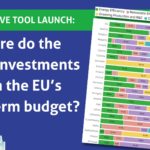BLOG POST
Some weeks after the COP26 concluded in Glasgow, CAN Europe summarised a few major outcomes focusing on mitigation and finance, what this means for the EU going forward, and how it can implement agreements in a way that is Fair for 1.5°C.
“Keeping 1.5°C within reach”: more ambition needed in the EU
The “Keeping 1.5°C within reach” motto was communicated early-on by the UK presidency and many others as a major benchmark for the COP. All the scientific reports clearly show that the world is by far not on track to stay within those boundaries, which are not safe for hundreds of millions of people, but which would most likely avoid devastating and irreversible planetary changes. This is obviously not the same as “ensuring we stay within 1.5°C” but there are of course also limitations to what the consensus-based agreements at a COP can achieve, as much of it comes down to national actions. Positively, in the end the ‘Glasgow Climate Pact’ and further COP decisions contain some very concrete steps on the issue of enhanced pre-2030 mitigation ambition, which is the centrepiece of any serious claim to keep 1.5°C within reach.
The COP requests parties to strengthen 2030 NDCs as necessary to align with the Paris Agreement temperature goal by the end of 2022. As no one can seriously claim that the EU’s 2030 targets are compatible with the 1.5°C limit – major scientific reports like Climate Tracker‘s come to that conclusion – the EU needs to figure out how to increase its ambition. The key entry point for the EU in 2022 is to turn its climate and energy legislative package ‘Fit for 55%’ into one that is ‘Fit for 1.5°C’, which would ensure significant emission reductions in the order of 65% (which is not in contrast with the agreed goal of “at least 55% emission reductions”). CAN Europe’s recommendations in that regard continue to be key benchmarks.
Small steps on financing for developing countries
Testament to the work of many developing country parties and civil society is that the Glasgow Climate Pact establishes the Glasgow Dialogues to discuss the arrangements for the funding of loss and damage activities, taking place at the first sessional period of the Subsidiary Body for Implementation (SBI) and concluding at its 60th session (in 2023). Earlier in the COP a number of EU Member States had signed up to the High Ambition Coalition Leaders Statement and recognised the need for finance to address loss and damage. However the US, UK and EU blocked a proposal from the G77 plus China on a loss and damage finance facility. The dialogues are a poor offering in exchange but do represent an opportunity to push this agenda. Although no clear indication in the text on deliverables of the dialogues, developing country parties are clear they will seek a concrete outcome on a financing facility and additional financing. With Ireland offering to host the dialogues, like-minded EU Member States should do their homework and understand existing proposals on the table, as well ensure clear outcomes from the discussions.
Aside from loss and damage financing needs, the unmet $100 billion of mitigation and adaptation finance goal, and an inadequate delivery plan was a major context for the finance negotiations going into COP26. Final COP26 decisions only noted parities’ “deep concern,” “urged developed countries to fully deliver” and did not result in adequate commitments to address gaps and deliver $600 billion over 2020-25 as agreed in the Paris Agreement. Developing countries did however secure a space to continue to discuss the $100 billion in the form of the extension of the long-term finance agenda until 2027 which had been due to sunset.
Going forward the EU needs to do more to deliver its collective fairshare, and it needs to recognise that financing needs to move from billions to trillions to reflect needs in the future finance goal. In the shorter term, Member States who have not increased their post-2020 climate finance including France, must do so urgently. As the EU revises its climate and energy legislation it should direct revenues from carbon taxation into climate finance. There is also the potential within the EU budget’s Global Europe Instrument to use a ‘cushion’ of funds reserved for emerging challenges and priorities to increase the climate contribution over 2021-27. Next, in order to build trust and enable scrutiny the EU should support the revision of the delivery plan ahead of the high level finance ministerial at COP27, and use the long term finance work programme to enable scrutiny and learn lessons not just on quantity but on modalities, access, impacts of climate finance. Developing countries are also calling for more action to ease fiscal space and enable green spending – which should be supported, but tools such as special drawing rights should not be counted towards the $100 billion.
On the adaptation share of climate finance, the Glasgow Climate Pact does call on rich countries to at least double collective provision of adaptation finance for developing countries from 2019 levels by 2025. How should the EU respond? CAN calls for at least 50% adaptation finance in the $100 billion. Collectively the EU attributes close to half of its finance to adaptation and ‘cross-cutting’, however dedicated adaptation projects stand at a low share of this. Contributors who contribute a low proportion of adaptation finance, including France, Germany and Spain should really step up their game. The EU should look to the EU Africa Summit to set out a stronger offer on dedicated adaptation funding including scaling up financing for the ‘African Adaptation Initiative’, as well as mainstreaming it across its investment package. Other Member States including those in the Adaptation Champions should continue to play an active diplomatic role to elevate the issue, which should also be helped now by the agreement of a Glasgow-Sharm el-Sheikh two-year work programme on the Global Goal on Adaptation.
Closing major gaps in the Paris Rulebook
Furthermore, the COP, after many years of negotiations and a recent shift in the EU position, agreed to Common Time Frames of 5 years for Nationally Determined Contributions (NDCs.) This means that all Parties are expected to present, in 2025, NDCs with 2035 emission reduction targets. Formally the EU has not adopted 2035 targets, but only for 2030 and, by provisions of the European Climate Law, plans to agree a 2040 target after the UNFCCC Global Stocktake in 2023. That will then be the time to also come up with a 2035 target which can be communicated to UNFCCC in its next NDC, in line and consistent with the European Climate Law.
Another unresolved element of the Paris rulebook has been the Article 6 rules setting the main rules for carbon markets under the Paris Agreement, with agreement found in Glasgow on its major elements. Weak rules here bear the risks of significantly undermining the environmental and social integrity of the Paris Agreement in a situation where the aggregate mitigation ambition is anyway wholly inadequate for the 1.5°C limit. Positively, despite attempts to do so by some developing country Parties even in the final hours of the COP, REDD+ projects have not been included within Article 6 rules. REDD+ projects have been found to be vulnerable to inflated baselines with minimal additionality. Another relatively good outcome iis the establishment of an independent grievance mechanism to strengthen the adherence to human rights and other safeguards, but with details to be developed further. On the downside, the market rules for the trade between governments (Art. 6.2) only “strongly encourage” countries to cancel some of the units to ensure overall mitigation outcomes and not a zero-sum game, instead of a binding approach (which is the case under Art. 6.4 with a mandatory cancellation rate of 2% from projects undertaken by private actors). At least, double counting of emission reduction units is excluded. Under Art. 6.4, unfortunately the agreement in the end allows parties to make use of old Clean Development Mechanism (CDM) project credits in the order of an estimated 300 million tonnes. Not making use of those will therefore be an important step for the EU to ensure this loophole does not undermine immediate climate action.
Some developed countries, notably in particular the US, also opposed the binding introduction of a share of proceeds from emission reductions for adaptation finance, and instead have only made vague voluntary promises to provide adaptation finance through other ways, as reported by Climate Home (under Article 6.4 a mandatory 5% share of proceeds will be applied).
Phasing down/out fossil fuel use indispensable
Provisions in the Glasgow Climate Pact which for the first time explicitly mention fossil fuels in a COP decision (if absurd in itself), can be looked at as an important political statement. This includes calls to “consider further action by 2030 on non-CO₂ emissions including methane” and “accelerate transition to low-emissions energy systems, scale up clean power generation and energy efficiency, and accelerate “efforts towards” the phase-down of “unabated” coal power and phase out of “inefficient” fossil fuel subsidies, while providing targeted support to the poorest and most vulnerable in line with national circumstances and recognizing the need for support towards a just transition.” While in particular India and China eventually insisted on the phase-down instead of phase-out language and the qualifying references to the poorest and most vulnerable, it would disregard global equity aspects if they would be put at the centre of blame. Developed countries, including the EU, were, unfortunately, not prepared to agree to language calling out all fossil fuels including gas and oil. And while coal is particularly problematic, many European countries have already come a long way in reducing their coal use (partially also because energy intensive industries having moved to China, India and elsewhere) where it is now a comparatively easier task than for the two Asian countries which are the home to almost third of the global population.
But countries clearly recognised the emissions gap to the 1.5°C limit, that major impacts can be avoided by keeping within that trajectory and that emissions need to be globally cut in the order of 45% by 2030 compared to 2010 to keep this limit. All fossil fuels need to be tackled for this to be achieved, and the EU needs to respond to the COP26 outcomes now in a way that accelerates the shift away from coal, oil and gas in line with the 1.5°C limit, and phases out fossil fuel subsidies. Furthermore, building on these agreements, the EU should now assess how to step up its bilateral cooperations with key countries.
Finally, one key thing on the 2022 to-do-list of the UNFCCC process will be the elaboration of a “work programme to scale up mitigation ambition and implementation”, with a decision aimed for by COP27, and a related high-level ministerial roundtable. The EU should come prepared to those discussions to make clear proposals how the collaboration of governments can accelerate action towards 1.5°C, emission reductions required in this decade, and how voluntary announcements from country and private sector alliances can be tracked.



